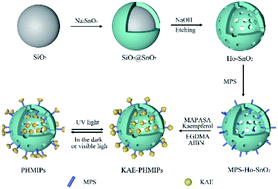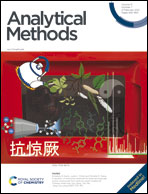Preparation and evaluation of photo-responsive hollow SnO2 molecularly imprinted polymers for the selective recognition of kaempferol
Abstract
Novel photo-responsive hollow structured molecularly imprinted polymers (PHMIPs) were developed as a selective sorbent to recognize and separate analytes in complex samples. The PHMIPs were prepared using kaempferol (KAE) as the template, 4-[(4-methacryloyloxy) phenylazo] benzenesulfonic acid as a photo-responsive functional monomer, and hollow SnO2 (Ho-SnO2) as the support via free radical polymerization. The structure and physical properties of the developed polymers were characterized using different nano structural techniques and spectroscopy. Under alternating irradiation at 365 and 440 nm, the PHMIPs could release and uptake KAE, indicating that the template molecules can be easily bound to recognition sites and released back into solution. From adsorption experiments, the binding properties were evaluated, and the maximal adsorption capacity of the PHMIPs was 11.04 mg g−1. Furthermore, the developed PHMIPs showed high selectivity towards KAE compared to other compounds. Subsequently, the materials were successfully applied to the photo-controlled extraction of KAE from sea buckthorn leaves. The recoveries for KAE were higher than 90% and relative standard deviation values were between 1.81% and 2.53%, indicating the potential of the developed materials for use in extracting KAE from complex samples.



 Please wait while we load your content...
Please wait while we load your content...